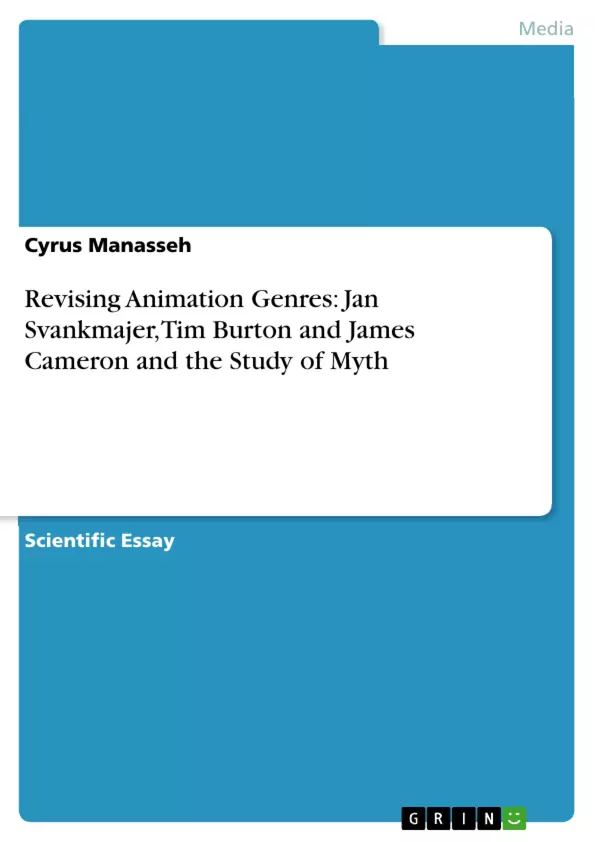This lecture ‘Revising Animation Genres: Jan Svankmajer, Tim Burton and James Cameron and the Study of Myth’ addresses the idea or concept of today’s classification of genres for animation feature films and interrogates why this concept needs to be revised today.
The lecture is also about what makes it possible to tell a story successfully within films that use animation visual effects today.
To do this, it discusses why the concept of the animation genre needs to be revised and suggests how today we need to look at the idea of genres in animation differently than we did in the past.
By contrast with the modernism of the past (when fixed styles in art and culture had existed, making it possible to create certain strong recognisable frameworks for art which had helped us categorise different styles and genres and types of film and types of stories), today, a lot more art and art making is made up from a lot of pastiche, which now sees the appropriating of a mixture of ideas from other contexts, genres and themes.
This appropriation of ideas previously not normally grouped together within an artwork or film or piece of animation is now being combined into an overall fraternizing of codes and references in films that often would employ animation visual effects.
Table of Contents
- Revising Animation Genres: Jan Svankmajer, Tim Burton and James Cameron and the Study of Myth
- The Age of Post-Post-Modernism
- The ‘Limitlessness’ of Animation
- Modernism and the Binary Logic
- How Animation Genres Are Being Revised
- Understanding the New Sub-Genres in Animation by Looking at Narratives
- Deep Structure and Archetypes
Objectives and Key Themes
This lecture explores the evolving landscape of animation genres, examining how the concept of genre needs to be redefined in the contemporary context. It delves into the factors influencing successful storytelling within animated films today, specifically focusing on the influence of technology and the rise of hybridity in animation.
- The shift from modernism to post-post-modernism in animation
- The impact of digital technology on animation genres
- The rise of hybridity and the blending of genres in animation
- The influence of narrative structure and deep structures on animation genres
- The importance of archetypes and the collective unconscious in storytelling
Chapter Summaries
- Revising Animation Genres: Jan Svankmajer, Tim Burton and James Cameron and the Study of Myth: This introductory chapter sets the stage by outlining the lecture's focus on the evolving nature of animation genres in a post-modern world. It discusses the influence of technological advancements, particularly digital technology, on the blurring of genre boundaries and the rise of hybridity in animation.
- The Age of Post-Post-Modernism: This chapter examines the transition from modernism to post-post-modernism, characterized by a proliferation of random ideas and a blurring of boundaries between the real and the virtual. It suggests that this shift in cultural context necessitates a rethinking of traditional genre classifications in animation.
- The ‘Limitlessness’ of Animation: This section delves into the concept of "limitlessness" in contemporary animation, where traditional boundaries and classifications are increasingly challenged. It explores how the fusion of ideas, themes, and references from diverse sources creates a new virtual reality in animation.
- Modernism and the Binary Logic: This chapter discusses the influence of modernism on animation, particularly the binary logic that underpinned traditional genre classifications. It highlights how this binary logic is being eroded in the post-post-modern context, leading to the emergence of new animation sub-genres.
- How Animation Genres Are Being Revised: This section examines how the rise of hybridity in animation has led to the development of new sub-genres. It explores how animators are combining and manipulating established genres and tropes to create unique and complex narrative structures.
- Understanding the New Sub-Genres in Animation by Looking at Narratives: This chapter emphasizes the importance of narrative structure in understanding contemporary animation sub-genres. It argues that narrative, rather than visual style, is the driving force behind the creation of new animation genres.
- Deep Structure and Archetypes: This section delves into the concept of "deep structure" and its influence on narrative. It discusses the importance of Joseph Campbell's monomyth (the hero's journey) and the role of archetypes in engaging audiences on an unconscious level.
Keywords
This lecture explores the evolving landscape of animation genres, focusing on themes such as hybridity, post-post-modernism, digital technology, narrative structure, deep structure, and archetypes. It analyzes the impact of these factors on the creation and reception of animated films in a contemporary context.
- Quote paper
- Cyrus Manasseh (Author), 2011, Revising Animation Genres: Jan Svankmajer, Tim Burton and James Cameron and the Study of Myth, Munich, GRIN Verlag, https://www.grin.com/document/305257



